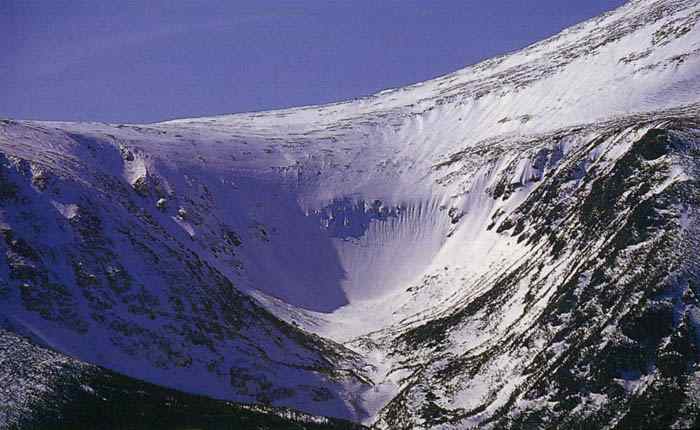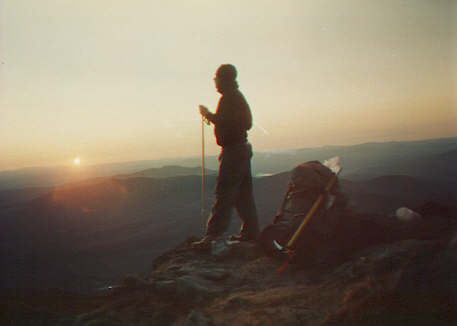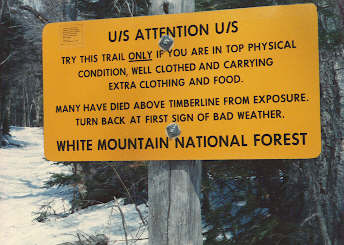Self Portrait 800 feet below the summit on the first day of winter, 1999. Summit conditions that day were about average for winter; 50 below zero, with a peak overnight wind gust of 80 MPH!
Mount Washington, the highest peak in the northeastern U.S, attains an elevation of 6,288 feet above mean sea level. Like most of my climbing buddies, I've climbed this thing a couple dozen times, and a few times in winter. If you are planning some serious expeditions in the Himalayas or other high places, this mountain is a great place to practice! Our best climbs have usually been in the winter when few others are on the mountain. It can be a dangerous world up there, but absolutely incredibly beautiful and surrealistic!
|
|
|
|
|
Self Portrait 800 feet below the summit on the first day
of winter, 1999. Summit
conditions that day were about average for winter; 50 below
zero, with a peak overnight wind gust of 80 MPH!
12/22/99; I took my glove off to take this self portrait
on the summit! (click
here to see the actual summit weather conditions for that day!)
| This live image is taken by a camera located inside the Mount Washington Observatory at the summit of Mount Washington, New Hampshire, the highest point in New England. It's looking east - northeast out of a window in the Observatory tower. |
I've also bivouacked near the summit
5 or 6 times. Don't bother using a tent up there; the wind will
rip it to shreds! Use a bivy sack instead.
One weekend Ricky and I were going to bivouac just below the summit,
and Bob was with us. Rick and I had full winter gear, but
Bob had none. Ricky let Bob borrow his three-season sleeping
bag so he could stay down low at Hojo's (Hermit Lake Shelters,
just below treeline). Bob wanted to stay up high with us,
but he only had the summer bag. He also had no Ice Ax, just
a ski pole! Sure enough, he froze his butt off! (Note; Bob
survived the ordeal, and then went down and spent a year and a
half at the
South Pole! Bob has gotten smarter over the years; he now
lives and works in Kauai!

Photo of the famous Tuckerman Ravine, just below
the summit. People hike up and ski here, sometimes naked, all
the way into July!
On another bivy, Dann, Ricky and I set up on the plateau just below the summit cone. The weather was nice, but it was summer, and very humid. When morning came, I poked my head out of my bivy sack, and could see nothing but fog. We were in the clouds! I yelled for those guys, but no one answered. I thought they were only about 6 feet away from me when I went to sleep, but they must have woken up and headed down below treeline during the night when the storm rolled in. So I crawled a couple feet, still in my sleeping bag, and there they were, six feet from me. But the wind was howling so bad, and the fog was so thick, that I couldn't see six feet away! An hour later, it was still so thick that we almost had to crawl down to treeline along Edmunds Path.
The coolest summer ascent is up Huntington Ravine and across the Alpine Garden. But beware, that is just about the steepest trail in the whole White Mountain National Forest. If you do go up that way, and have lots of time left over, a great way down is along Boott Spur. It makes for a 12 hour day, but its an awesome loop.
Another great hike, and my first ascent, was up Ammonoosuc, and down Jewell. These are on the west side, and have the advantage of the late day sun. Very excellent loop!
Caps Ridge trail, also from the west, is totally awesome! This trail starts at 3000 feet, goes up Jefferson, and connects to several other trails! Very cool!
I've bivied near Lake of the Clouds hut many times, usually in Spring while doing the Tuckerman Ravine Spring Skiing thing. There are lots of great places to set up, like near the summit of Monroe, although it is illegal to camp above treeline (~4000 feet) except during winter when the snowpack underneath you is at least two feet deep. If you get caught camping illegally up there, the fines are pretty steep. If you get caught unexpectedly by the weather, the penalty can be much worse. If this sort of weird "recreation" really appeals to you, your best bet would be to contact one of the mountain guide services down in North Conway, such as IME, EMS, etc
. -------
------- 
Sunset, near summit of Mount Monroe; getting ready to spend a long cold night!
(We always get up to "Tuck's"
for the spring skiing at least once every April-June. Bring
shorts and a tee-shirt, and plenty of sunblock.)
Also did a couple bivies on Mt. Monroe, but if a storm comes in while you are up there, its all over!
Dann and I bivied once on the east side near Glen Boulder. During dinner, we watched the fog roll in, and rise up to slowly envelop everything below about 3000 feet. The undercast stayed all night, and all the peaks above 3500 feet were like "islands in the sky".
Once in the winter, Ricky and I got "lost" on the way down from the plateau above Tuckerman Ravine, and ended up wondering around up there until after midnight. We almost gave up and crawled into the single bivouac sack that we always carry, but Ricky had a real bad case of nasty farts all afternoon, so we decided not to give up looking for a way down until failing headlamps or safety forced us to halt. By two a.m. we had returned down to Pinkham Notch, had snuck past the guard, and were asleep on the floor of the library. We were real happy to get down off the mountain that night!
We've done some nice Ice Climbs up in the ravines. Also some cool Winter Ascents. Our last attempt was the final day of winter in 1998. We needed full winter gear, including crampons and ice ax. We got part way up the summit cone, to within about 800 feet of the summit. The fog was thick, visibility was about 100 feet, and worst of all, avalanche conditions just below the summit were severe. All the parties were turning back, so we did too. We had an excellent winter climb that day, but the summit was not to be. Two weeks later I was up there in a tee-shirt! Go figure!
In my opinion, Mount Washington is truly the Grand Teton of the East!
Please Note; over a hundred people have died on Mount Washington in recent years. Many others survive a horrifying ordeal, but usually only after putting dozens of volunteer rescue personnel in harms way. If you decide to go out to these wild places and put yourself in these conditions, be responsible for yourself and those in your party. There are many requirements; good judgment, common sense, experience, and leadership are just a few. Unexpected things can and do happen.... if your hat or gloves blow away in the wind, you head off on the wrong trail, or you slip and blow out a knee, you might get to find out what freezing to death is like! Your cell phone and GPS unit are not going to be able to save you. Self-rescue will be your best and maybe your only option. Be Prepared. Expect the unexpected. Always carry a bivy sack on every climb. Be prepared to spend the night up there! Plan for the worst, but hope for the best!
Photo of John and Ricky (on the right) about one thousand feet below the summit on the first day of winter, 1999. Note the crampons on the lead guy's feet; he must be standing on solid ice.
(The guys I climb with are sort of strange, just like me. We've planned ahead for what to do when things do go wrong. If you know that you or your climbing partner are about to freeze to death, then just before you drift off into lala-land, do this.... Take your backpack off, lay flat on your back, with your legs together, feet pointed up, hands on your ears, elbows pointed up, head tilted slightly upward. It will make the recovery for the rescuers a whole lot easier. Your corpse will freeze in the shape of a toboggan, and a couple of the rescue volunteers can sit on you, hold on to your elbows and feet, and and ride you down the mountain without wasting a body bag! **** Another good tip; the Big Rock technique....(warning! discuss these things ahead of time!) but if your buddy is close to death, and rescue would be really difficult, but recovery of the corpse would be relatively easy a couple days later after the climb is completed,,,, then find a big rock and finish the guy off! Ricky, Dann and I all wear just about the the same size boots and outerwear, so we might as well put the gear to use and finish the climb! *** Also, if you are freezing to death and it is really windy, then wrap your hands tightly around a tree to keep from getting blown off the mountain. It makes things tougher for the rescue crew, but some of them carry hand saws just for these situations. *** One more tip; when the Johnny Walker becomes slushy and difficult to pour out of the flask, you should realize that the temperature has fallen below the danger level, and it is time to head down off the mountain. ***Choosing the appropriate backpacking stove is critical in harsh winter conditions; *** Dann uses Bacardi 151 or Devils Springs 160 proof vodka in his MSR-XGK Multi-fuel stove,,,, that way if it is too windy to cook, he's not too upset, since he didn't carry all that stove fuel for nothing! Plus he sometimes gets free handouts of food or drink from other climbers that see him drinking his stove fuel and think that he's whacko!)
Page created by Tim D; August 1999 (updated 11/20/09)